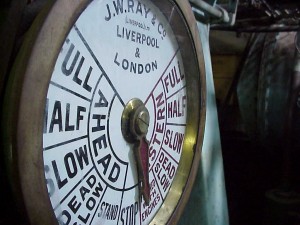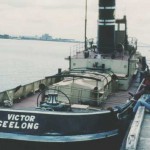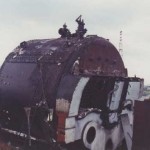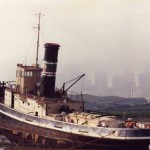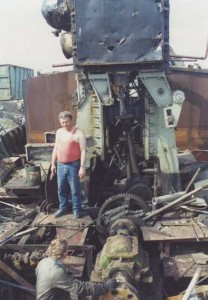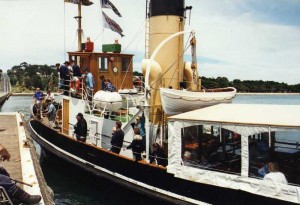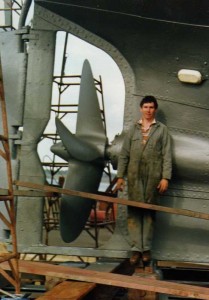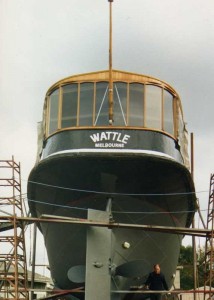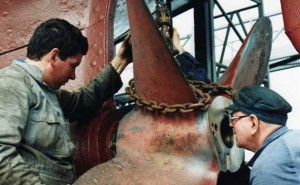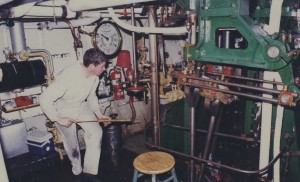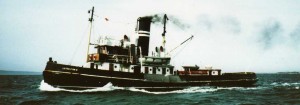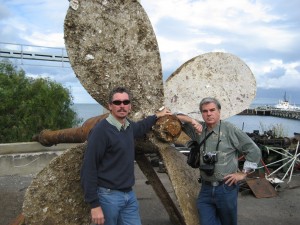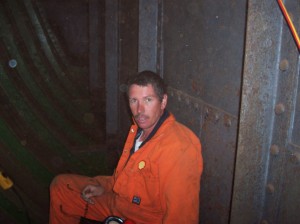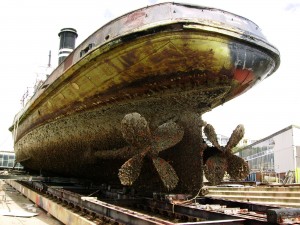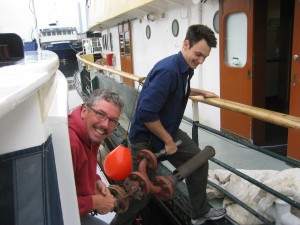Steamtugs?
I have always wanted to be the chief engineer of a steam tug and tried 3 times in my life to have a jolly good tug! Somebody once said to me “Why do you like ships?” to which the answer is “actually, I don’t like ships, but they are good for keeping the sea off my lovely engine!”
It all started while I was doing my apprenticship as a steam engine driver in a local powerstation. A mate of mine who I knew through Amateur radio (another old hobby I had as a school boy) brought a group of local men who had bouhgt an old Geelong steamtug with the hopes of restoring it to operating condition and taking people for rides around Corio Bay here in Geelong.
People don’t understand what it’s like to be aboard a steamship. It’s the best thing ever! You have all the advantages of sailing in silence, while the decks stay upright and you can make weigh even when the wind doesn’t blow, steaming across a glassy sea in silence… there is nothing like it!!!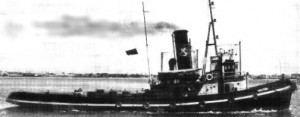
Steamtug “VICTOR”
Steamtug Victor was built in wartime 1943 in a river on the North East coast of “jordy” England as the Empire Ben. She was sold to the Geelong Harbour trust after the war and served the Port of Geelong up until her retirement. When I arrived on the team, she needed to have all her boiler tubes replaced because of failure of the feedwater filters to remove lube oil from the boiler feedwater coming back from the engine had caused a film build up of oil on the water side of the boiler tubes which caused them to overheat and fail.
We tried to save her with very limited resources but the only assistance we got from anybody, was free rent of a berth at the old dis-used Yarra Street pier in central Geelong. We lobbied everyone from the city council to state government but without any forthecoming funding, the vessel’s condition deteriorated to the point it was at risk of sinking at the berth. There was no alternative left than to send to the breakers.
Built 1933 in Sydney as a training program to keep the naval dockyard’s apprentices employed during the depression. She was taken over by the Royal Australian Navy, crewed by civilian crew and spent her life as a work boat around the naval dockyard. Apart from assisting the navy’s fleet onto the slipway, she performed an interesting task towing gunery targets out to sea for the navy to practise on. Fortunately they were good shots!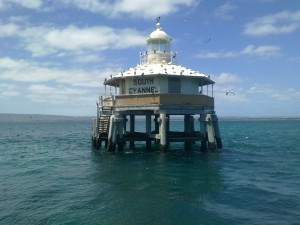
In the early 1980’s she came to Melbourne, underwent an extensive re-fit by the Victorian Steamship Association and went to work as a tourist ship in the Port of Melbourne. I worked on her as Chief engineer (a great title, but since I was the only engineer, I can call myself chief, can’t I?) During every summer holiday period we took her out of her home port to the beach side holiday resort of Rye. Living onboard, we worked her everyday taking tourists out to the seal colony on the South Channel Pile light before returning to her home port a week later for the next crew to take over.
I must recall one interesting story about leaving Rye after our week, on a glassy sea. The conditions were perfect, but we could see the sky had different plans ahead. We battened down hatches and braced ourselves for one of the worst storms I have seen at sea. In torrential rain and zero visability we slowed the engines with the whistle sounding our way forward. The captain noticed a small speed/fishing boat sheltering on our leigh side. The captain went to the wing of the bridge and called “Are you OK?” to which the reply came “Yes. We are trying to find our way to Rye and since we know you are from Rye, we will follow you back.” to which our captain replied “We are headed for Melbourne, Rye is that way!!!” To which the small boat turned and disappeared into the darkness.
The Wattle traded successfully for many years and even turned a profit. When the opportunity to purchase another tug about to be scrapped came upon us, it was decided we had to resources to take on this challenge too. But financial times changed. The second tug was left stagnant for a long time until eventually it was unloaded to 3 silly people with grand ideas, one of whom was me! The Wattle then lapsed out of Marine Board survey and facing a bleak future, was eventually sold to private enterprise who is using the old steamship association members to help restore her.
Steamtug Wattle preparing for sea Steamtug Wattle’s engine goes around… and around…
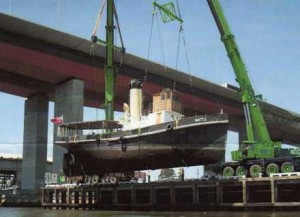 Currently, she sits on concrete blocks on the quay side at South wharf, just under the Bolte Bridge in Melbourne where plate by plate, the hull is taken down, remade or repaired and re-riveted in the old fashion back onto the ship. I believe the ship will be save because she is Australian built, but it’s a pity she had to be sold into private ownership. They are desperate for help with this, so if you would like a new project in your life, get onboard. They would be grateful of any help. Here is the latest webpage, which unfortunately has never been updated since she was last steaming.
Currently, she sits on concrete blocks on the quay side at South wharf, just under the Bolte Bridge in Melbourne where plate by plate, the hull is taken down, remade or repaired and re-riveted in the old fashion back onto the ship. I believe the ship will be save because she is Australian built, but it’s a pity she had to be sold into private ownership. They are desperate for help with this, so if you would like a new project in your life, get onboard. They would be grateful of any help. Here is the latest webpage, which unfortunately has never been updated since she was last steaming.
http://www.sorrentosteam.com.au/index.htm
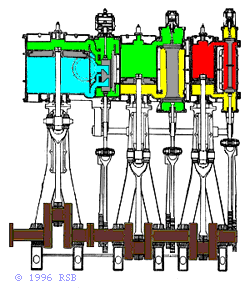 There is nothing so sweet as the sight of a triple expansion engine rolling over slowly, and Tug 2 as we called her had 2 of them!
There is nothing so sweet as the sight of a triple expansion engine rolling over slowly, and Tug 2 as we called her had 2 of them!
The Wattle was powered by a little compond engine. This means the steam is expanded twice by passing the steam from the smaller high pressure cylinder to the larger low pressure cylinder all designed to use the steam economically. Lyttelton II’s engines were twin triple expansion each driving it’s own big propeller.
T.S.T. Lyttelton II (twin screw tug) was ordered from Lobnitz and Co of Renfrew, on the Clyde River in Glasgow Scotland, by the Lyttelton Harbour board of New Zealand. The firm had a strong reputation for building salvage, dregding and tug equipment and completed their order in 1938, with the tug commencing her voyage to New Zealand on 17th March 1939, arriving on the 8th June of that year. She was built to the highest standard possible, displaced 303 tonnes and could boast a bollard pull of 13 tonnes. (Modern diesel tugs often have a rating of 50 tonnes bollard pull, but they aren’t as pretty as a steamtug). She joined her sister Tug Lyttelton, which still operates in New Zealand as a tourist ferry today, ( http://www.tuglyttelton.co.nz/ ) taking up her role as the principle salvage tug for the Far East, South Pacific area East of New Zealand.
She was finally retired and purchased by a group of tug enthusiasts who ran her around Sydney Harbour and was reputed at one point to be fired by used telephone books soaked in kerosene and sump oil! She had been kept in Lloyds 100-A1 survey up until she was sold, so was in excellent condition.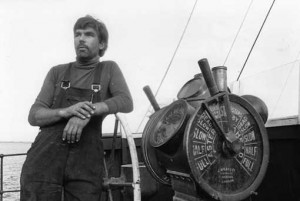
Ned Dawson, a Melbourne sound recordest with the film and television industry, was looking for a career change and thought being a shipping magnet (spelt correctly as he attracts rusty stuff) would be a good thing and purchased a steamtug. I had never met Ned then, but now count him as one of my mates, and a legend because, if you look at the credits on the original Mad Max movie, there is Neddy Seagoon (as I call him) listed there as the sound guru.
We were doing some routine work aboard the steamtug Victor in Geelong one Sunday afternoon, when this bloke came aboard, introduced himself as Ned Dawson, the owner of the steamtug that had arrived in Geelong the day before and wanted to have a look around our tug and get some ideas. Of, course he was Ned, and only a few months later contacted me as the only person he knew in Geelong to help him get steam up on his tug to prepare it for a trip to Melbourne where it was going up on Duke & Orr’s dry dock.
 I arranged a truck load of wood, lit up the boilers, went to work at Shell Geelong for my afternoon shift, returning at midnight to continue warming the boilers, sleeping in the stokehold, sitting on a kerosene tin with head in hands for a couple of days until finally we were ready to turn the main engines over; and what a magnificent site too see! Later that afternoon, the crew from the Wattle all came down to help with the 5 hour journey to Melbourne.
I arranged a truck load of wood, lit up the boilers, went to work at Shell Geelong for my afternoon shift, returning at midnight to continue warming the boilers, sleeping in the stokehold, sitting on a kerosene tin with head in hands for a couple of days until finally we were ready to turn the main engines over; and what a magnificent site too see! Later that afternoon, the crew from the Wattle all came down to help with the 5 hour journey to Melbourne.
These Wattle people were foreign to me as Melbourne being so far away, I never would have contimplated I would join them one day. We left for Melbourne late in the afternoon and with poor quality, fire proof coal that almost refused to burn, but instead clinkered up on the grates, and sooted up our boilers, the journey took 7 hours in the worst weather imaginable. I was on watch as a fireman with the stokehold running around 55 degC with sweat rag around my neck, water bottle hanging in the ventilator shaft above, and 6 hungry fires all greedily wanting to be fed. We had to slice the coal off the grates with each charge to keep it broken up so the air could flow through the bed, and when number 6 was finally done, number 1 was ready to be fed again. Whew… imagine liners like the Lusitania. She had 150 fires, 150 firemen, and burned up 1000 tons of coal per day, all hand fired! One of the other fireman on my watch was a cremetorium attendant from Sydney (part of the original crew) who kept asking me to pass him the bone pick, and the skull cracker. Eerie!
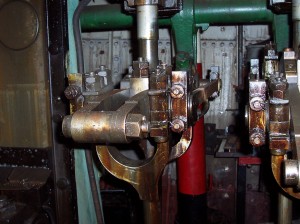
As happens with steamtugs, an inspection out of the water revealed the amount of money to fix all the problems is more than the owner can afford, and she was undercoated and put back in the water with her rudder on the aft deck, and confiscated until money could be found to pay the bill. This never happened, so she was given to the steamship association. Work on her restoration progressed until she got too much for them too, so the old captain I had served with on Wattle made a proposal that he, myself and another engineer Ross should take the tug over.
After lots of hard work, we too could see no way to save this grand old tug, and with a taste in my mouth all too familiar, and nobody giving a damn about Melbourne’s Maritime Heritage, there was no other option than to scrap her. “Oh she is not an Australian tug, why should we save her?” Because there are no other steamtugs left in operation in Australia. Fortunately the Melbourne Traction Engine club took the whole engineroom and boilers, with hull plate sections and a bold plan to put it all back together as a shore based display where the engines can be run, and visitors can once again get the feeling of going below decks in a steamship. I hope it comes together. Since then, I have aquired the ship’s whistle and name board.
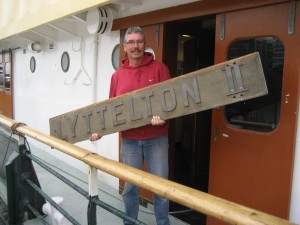 Where is Victoria’s maritime museum?
Where is Victoria’s maritime museum?
A plan was hatched a few years back when the Port of Melbourne Authority vacated their old workshops in  Williamstown. A grand maritime museum could be made and historic vessels like Wattle, Lyttelton II, the schooner Alma Dopel and Enterprize could all pool resources, restore the slipway and vessels could be pulled up without a time constraint and bit by bit, be restored with the time needed for a volunteer organisation to carry out major works. Unfortunately to this day, there has still not been a decision on whether this could be made reality. Too late for tug 2, but ask yourself and your local MP, Why does every capital city in Australia have a maritime museum except Victoria? The Maritime Heritage Victoria is working with the government in an attempt to make this happen, but after years of sitting on their hands, nothing has happened. See MHAV website here… http://www.mhav.net/
Williamstown. A grand maritime museum could be made and historic vessels like Wattle, Lyttelton II, the schooner Alma Dopel and Enterprize could all pool resources, restore the slipway and vessels could be pulled up without a time constraint and bit by bit, be restored with the time needed for a volunteer organisation to carry out major works. Unfortunately to this day, there has still not been a decision on whether this could be made reality. Too late for tug 2, but ask yourself and your local MP, Why does every capital city in Australia have a maritime museum except Victoria? The Maritime Heritage Victoria is working with the government in an attempt to make this happen, but after years of sitting on their hands, nothing has happened. See MHAV website here… http://www.mhav.net/
Further reading…
LYTTLETON II RIP a document I wrote for a magazine about the wrecking of Tug 2
PROPOSAL FOR Lyttelton II about the plans I made on how to convert the tug to a ferry
Ikki Allen, World’s Greatest Steam Engineer Written for the funeral of my long serving fireman and college “Ikki”
tug engineroom a powerpoint picture I drew to look important while stranded in an airport in Korea
The Steam injector an article I wrote for a club magazine Nov 2011
